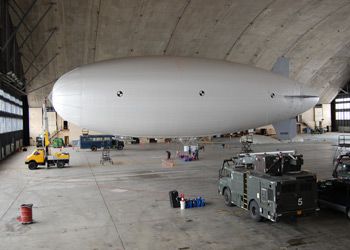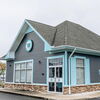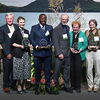Eye in the sky | Drug runners, illegal immigrants and Mother Nature take note: Telford Group's blimp might soon be watching
 Photo/Whit Richardson
The Skybus 80K floats in a hangar at the former Loring Air Force Base in Limestone. The Loring division of the Telford Group Inc. is developing the blimp for a range of surveillance and security uses. "It's a pretty multi-functional system," says Facility Manager Steve Oullette, pictured standing under the blimp.
Photo/Whit Richardson
The Skybus 80K floats in a hangar at the former Loring Air Force Base in Limestone. The Loring division of the Telford Group Inc. is developing the blimp for a range of surveillance and security uses. "It's a pretty multi-functional system," says Facility Manager Steve Oullette, pictured standing under the blimp.
Skybus 80K floats in the stale air of an old Loring Air Force Base military hangar that once sheltered B-52 bombers. Tethered by ropes and weighted with yellow and blue sandbags, the huge unmanned airship is typically seen only by the eight-man crew working on its flight and data systems and the occasional pigeon roosting in the rafters.
But by the end of May, the white, 80,000-cubic-foot blimp will be launched into the Aroostook County spring air on a test flight in preparation for its public unveiling to prospective buyers later this summer. If all goes well, the Loring hangar could one day become a manufacturing and training facility for unmanned airships.
The Skybus 80K is the brainchild of the Loring research and development division of Telford Group Inc., a subsidiary of Bangor’s Telford Aviation founded by President Bob Ziegelaar. For the past four years, this division of Telford Group has developed unmanned airships whose surveillance potential has caught the interest of the Department of Homeland Security, the U.S. Customs Border Patrol, the U.S. Coast Guard and other government agencies. At a sale price of roughly $1 million, Telford Group hopes the Skybus will bring new business to the privately held company, as well as a boost to the local economy through a new production and training facility that could employ 30 or more people.
“We hope to do a demonstration for the U.S. government in August or early September,” says Ziegelaar. “Once we demonstrate the viability of this technology for border surveillance, port security, disaster relief purposes, then we can get it ready for market.”
Several companies are developing aircraft that can perform surveillance applications, but the Loring unit of Telford Group is the only one to receive an experimental certificate from the Federal Aviation Administration for an unmanned, lighter-than-air craft, the term the FAA uses to define airships, hot-air balloons and other craft made buoyant by gas. The certificate, awarded in April, allows Telford to execute demonstration flights and R&D test flights with the Skybus in civilian airspace, a crucial step in preparing it for the civilian market.
“I believe all the other [unmanned aircraft] systems that have been given experimental certificates have been heavier than air,” says Les Dorr, a spokesman within the FAA’s Office of Communication and Public Affairs. So far, 13 experimental certificates have been awarded to unmanned aircraft manufacturers, with more requests pending. The FAA website describes unmanned aircraft as a developing segment of the aviation industry that could help law enforcement, homeland security, firefighting, weather prediction and search-and-rescue missions.
The benefits of being a blimp
Steve Ouellette, Telford’s facility manager at Loring, says the Maine operation is well ahead of its competitors. An aviation mechanic by training, Ouellette stands in the hangar and ticks off on his fingers Skybus’ advantages over the pack: It can easily carry a payload of 750 pounds and is designed to travel at 15,000 feet within a 15- to 20-mile radius from its ground station. Most importantly, says Ouellette, it can stay airborne for 32 hours, while surveillance fixed-wing aircraft and helicopters max out at seven hours.
“A lot of people don’t know that an airship can hover,” he says. “There are a lot of applications that make it an ideal observation platform.”
For instance, patrols at the U.S.-Mexico border currently use aerostats, stationary blimps tethered to the ground. They hold sensors fine-tuned to observe movement. But because they are stationary and typically don’t exceed altitudes of 12,000 feet, their viewing range is limited.
“The higher you are determines how much more you can see,” says Ouellette. “We’ll be able to [with the Skybus] patrol up and down the border and can keep an eye on a much larger area.”
Competition for the surveillance work is stiff. A handful of companies are developing unmanned vehicles for surveillance that must be propelled into the air, such as airplanes and helicopters, says Ziegelaar. Lighter-than-air craft like Telford’s are cheaper to build and operate. The Skybus 80K would cost about a quarter the price of a Predator, the $4 million fixed-wing, missile-toting aircraft developed for the Air Force for reconnaissance missions and raids. One of Telford’s biggest rivals, North Carolina-based Blackwater Airships, is working on the Polar 400, a blimp that dwarfs the Skybus by 60,000 cubic feet. But it doesn’t have an experimental certificate, giving Telford an edge in getting Skybus to market.
“There is nothing in our price range that can lift 500 pounds to 10,000 or 15,000 feet,” says Ziegelaar.
Blimps like Telford’s can be used to monitor seacoasts and shipping lanes for drug runners, expanding the reach of the Coast Guard. Homeland Security could apply its motion technology to detect illegal immigrants along the U.S. border. Add infrared technology to the blimp’s payload and the government could find terrorists hiding in remote terrain. Affix audio detection technology and it could even overhear conversations.
Besides the Big-Brother applications, Skybus can help restore cell phone service and other communications when transmission towers topple after a natural disaster such as a hurricane.
“You could put an antenna on an airship, send it up 1,000 feet and communications could be restored,” Ouellette says.
Floating into history
The notion of using the sky as a surveillance platform isn’t new, nor is the technology, which was invented in the 18th century. Dirigibles carried bombs into London during raids in World War I and were moderately successful as passenger vehicles until the 1937 Hindenburg disaster that killed 36 people in New Jersey. Today, most people associate blimps with ad campaigns and sporting events.
But in the 1980s, Scientific Applications International Corp., a Virginia-based company, began experimenting with airships for commercial and government use. They weren’t successful, says Telford’s Ziegelaar, but five years ago Scientific Applications approached Telford Aviation to collaborate on R&D that eventually produced Skybus 30K, the 30,000-cubic-foot forerunner of Skybus 80K. The two companies had collaborated before, and SAIC’s research and engineering skills complemented Telford’s technical and mechanical resources.
Ziegelaar says the companies have invested about a half a million dollars in the Skybus technology, as well as hundreds of man-hours. Thanks to the lobbying of U.S. Sen. Susan Collins, the project has also been able to secure between $4 million and $5 million in government grants, said Ziegelaar. If the Department of Defense continues its support of the project, Ziegelaar expects to receive another $2 million to $3 million next year. Eventually SAIC, which maintains a sprawling R&D facility in Virginia, wants to manufacture and test airships at Loring, and to train crew there.
“There are a number of different firms trying out different concepts,” says Ziegelaar of his competition. Even if other companies build their own airships, Loring could be the center for training crews and test flights, providing more than 30 jobs. Both the manufacturing facility and training center would expand the diversity of Telford’s operation, but it’s too soon to predict revenues from the enterprise, says Zeigelaar.
Air power
The Telford airship looks like it could orbit a Super Bowl game. Its fabric shell is composed of a series of cells, or pockets, some filled with helium and some filled with air. The Skybus is unmanned and is controlled by radio waves from an operator in a ground station with a more sophisticated version of the technology used by model airplane enthusiasts to fly their planes.
The Skybus is powered by a turbo-charged, 115-horsepower Bombardier Rotax engine, which propels the vehicle at an average speed of 40 knots. Coupled with its 30-plus-hour flying time, it can travel a distance of 600 miles and back, says Ouellette.
The shell is made from a specialized coated fabric that prevents the helium from seeping out of the cells. Ouellette says helium atoms are so small, they can escape from a stainless steel box welded shut. The Skybus has no internal structure; differential pressure keeps it rigid.
Dorr, of the FAA, says the agency is developing policies and procedures around unmanned aircraft as more civilian operators consider the potential of the craft. The greatest safety threat is the lack of a human pilot to detect and avoid collisions. Dorr estimates the technology for a fully automated anti-collision system is at least four years away. Until then, unmanned airships will have to be monitored and controlled by a human operator on the ground.
Ouellette says Skybus’ size works in its favor, as far as safety goes. “It’s not like you can’t see it,” he quips. During its test flights, Skybus crew members must monitor the airship during takeoff, landing and flight, and watch for other aircraft operating in the same airspace. Satellites could eventually control the airship at some point in the future, says Ouellette, and could allow the Skybus to fly around the world.
“It’s a pretty multi-functional system,” says Ouellette of Skybus 80K. “It’s only limited by imagination in terms of what the equipment can do and what you want it to do.”
Carol Coultas, Mainebiz editor, can be reached at ccoultas@mainebiz.biz.










Comments